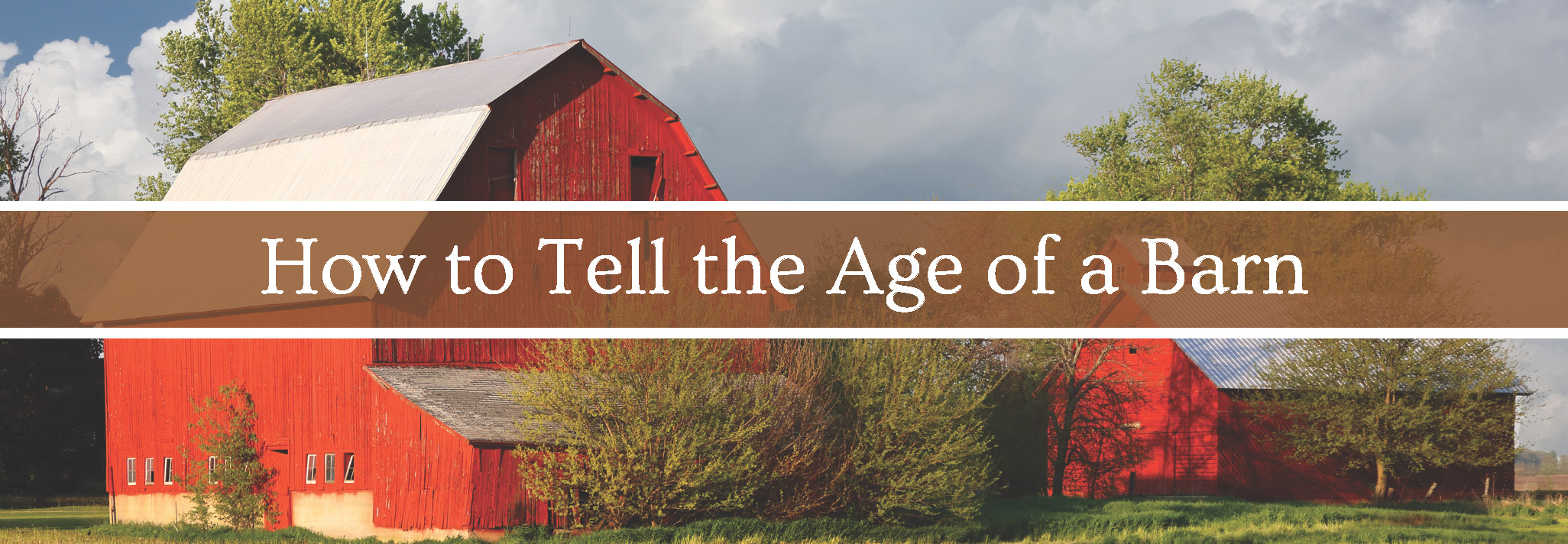
The barns of yesteryear are as majestic a part of the American countryside as cow-dotted pastures or the sun setting behind the hills. Weathered but proud, they stand among fields and modern farmsteads as a testament to the work of our forefathers. They are a piece of our story, and will hopefully be with us a long time yet.
However much they speak to us, though, barns can be awfully good at keeping a secret.
Most old barns are a bit bashful about revealing their age. Trying to figure out the age of a barn is tricky for several reasons.
The barn had to get built. Winter was on its way and there was nowhere to keep the hay dry. Wolves were picking off the sheep and cows one by one. Tools were rusting, and grain was spoiling. That meant the barn went up in a hurry, using utilitarian processes. There probably wasn’t much time to celebrate the achievement — it was more important to get on with the workload ahead.
However, if you know what to look for, it is possible to zero in on the age of an old barn. If you’re lucky enough to have one on your property or in your neighborhood, here’s how to get an idea of how long it was there before you.
Know the History of Barns in Your Area
Europeans settled in different parts of the United States at different times. To begin the investigation of what era your barn might have been built in, it’s a good idea to figure out exactly when the settlers first arrived. At the very least, this gives you an upper limit on the age of your barn — if settlers arrived 150 years ago, for instance, there’s little chance your barn is older than that.
Depending on where you live in the country, this history will obviously be different. Here are some general facts about when different areas were settled.
- The East Coast: This area has been home to European settlers more or less since the early 1600s. This period was when Sir Francis Drake, Samuel de Champlain and John Smith were active in mapping and establishing forts. Additionally, the Dutch took interest in what is today New York City, and Pilgrims rapidly laid roots in New England. Over the following centuries, land traded hands among the British, French and Spanish.
- The eastern Midwest: Around the mid-1700s, the British took control of the Midwest. France had previously controlled this area, and once the French were expelled, it became the frontier against Spanish country. After the American Revolution in the late 1700s, it belonged to the United States, where it has remained ever since.
- The western Midwest: The U.S. government claimed this territory in 1803 through the Louisiana Purchase, and its western boundary stretches from Montana through the eastern portions of Wyoming, Colorado and New Mexico. Its eastern line roughly follows the Mississippi River. If you live in this area, it is safe to use the Louisiana Purchase as a lower limit to the year of your barn’s inception.
- The West: From the line of the Louisiana Purchase to the Pacific Ocean lies the final conquest of the United States. This entire territory was largely incorporated into the United States by the mid-1800s. If you live in the Southwest, Northwest or near the West Coast, you can fairly safely place the lower limit of your barn’s inception around 1850.
Of course, there will be variations within this broad set of brushstrokes. Want a more reliable figure for the earliest year your barn could have been built? Look up your local history. For instance, some areas of the east coast, which has been settled for more than 400 years, experienced an influx of farmers in the late 1800s or early 1900s.
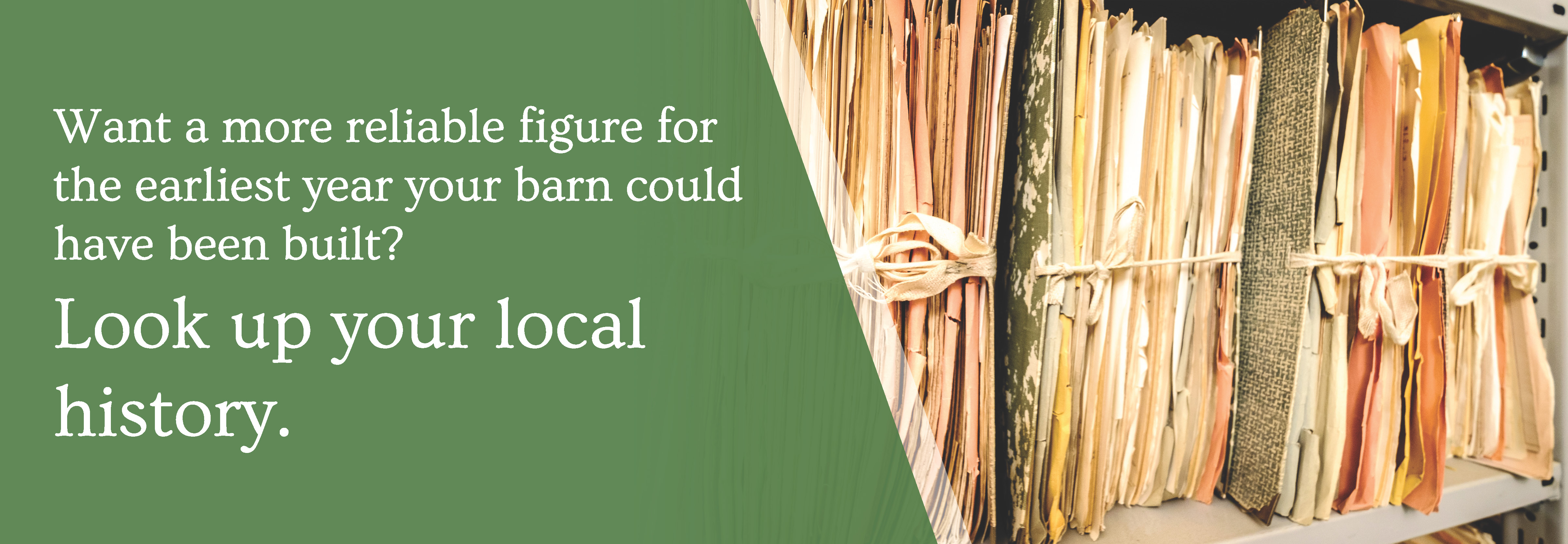
Ultimately, learning the local history is going to prove quite valuable — and while you have your nose in a book, you may as well take a look at the tax records.
Search the Tax Records
When a surveyor must figure out the history of a piece of land, one of the most valuable investigatory tools available is the tax record. Tax records often date back to the first settlers of an area, taking record of those to whom the land was either sold or allotted.
Though tax records may give clues as to when a barn was built, the specific information on the barn may also be omitted if the records are very old. This is because early settlers, when settling a piece of land, often felled trees and used them to make a log cabin. After the log cabin was built, they would clear more trees and construct a barn. They would then be able to start working and making money off the land.
After the barn was finished, they would focus on building a proper farmhouse to fit their family. Regrettably, it is often the case that the tax record reflects the construction of the house, but not the barn.
So, while the tax records probably won’t give you a definitive answer on the age of your barn, they can give you some idea as to the age of the main house on the property. This information will probably narrow down your search to within a decade or so.
To search the tax record on your property, you’ll need to head to the spot in your county where the records are liable to be kept. This could be the county courthouse, the city hall or a recorder’s office. You may be able to ask the staff to help you find property deeds as well.
Examine How the Barn Was Built
The construction of barns has changed through time in response to different technologies. By studying how your barn is constructed, you can glean some information on when it might have been raised. One telltale sign of a barn’s youthfulness — relatively speaking — is the shape of its roof and the height of its walls. Barns are massive structures, and the shape of their roofs can make a significant difference in their internal volume. This internal volume, in turn, affects how much hay can be stored inside the barn.
Older barns were built low, with a gabled roof. The gable is that triangular wall of a barn that forms the end of a pitched roof. When farmers stored hay in the old days, they did so with a pitchfork, which limited the amount of hay they could store in a barn.
Around the mid-1880s, however, William Louden’s hay truck had caught on. In addition, his company came out with a line of hay-handling equipment that made it possible to unload larger amounts at a faster speed, allowing greater amounts of hay to be stored in a barn. The only problem now was the gabled roof. The ceiling was so steep, farmers could only pile hay to a certain height above the walls, which were roughly 12 feet tall.
That’s why barns began using gambrel roofs around this period. A gambrel roof is the one we immediately associate with barns, with two slopes on each side of the ridge. This design increased the internal volume of the barn, allowing more hay to be stacked. Additionally, farmers began building their barns with taller walls.
If your barn has a gambrel roof, it is still possible the barn is older than the 1880s. Many older barns built with gabled roofs simply had their roofs rebuilt to accommodate more hay. If the barn has roughly 12-foot walls and also has a gambrel roof, there is a good chance it could be older — the roof might have just been altered.
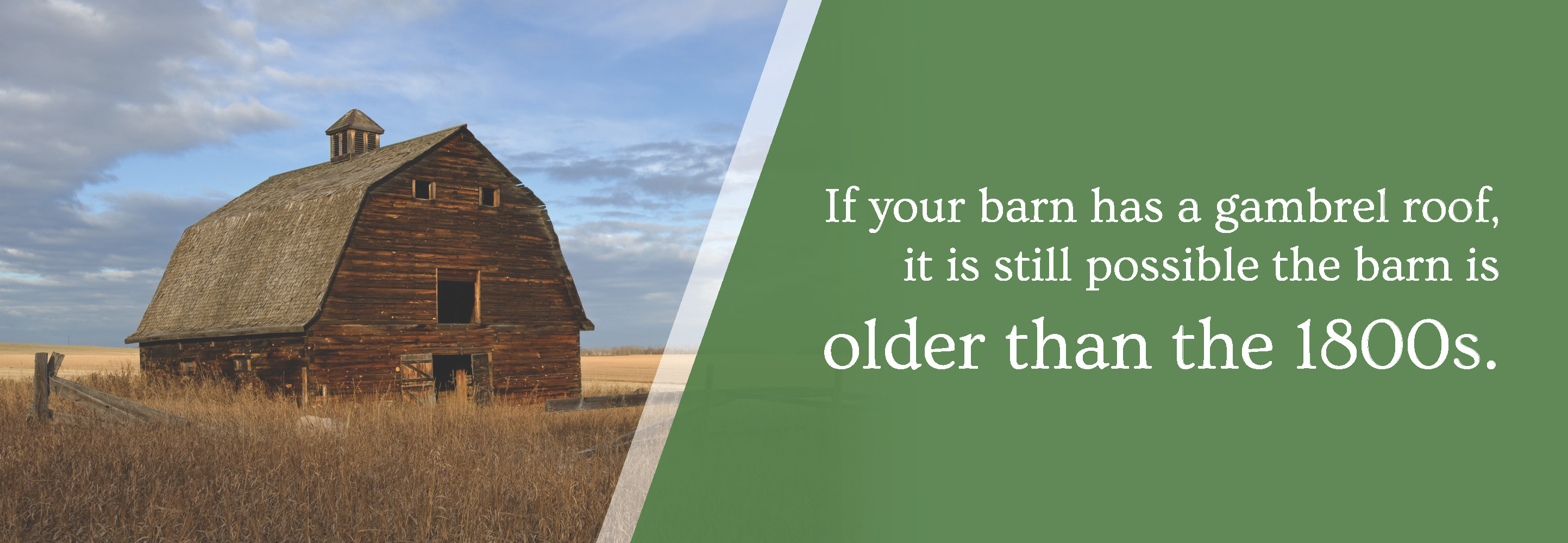
How Is the Barn Framed?
Framing barns is another science that has evolved greatly in the last two centuries. Take a gander at the overall structure of the frame — it has a lot to tell you about the barn’s age.
Older barns, particularly those with gabled roofs, tended to use more stabilizing structures than newer barns. These included ceiling joists and tie beams that ran from the top of one wall to the top of the other. Purlins, which are vertical or perpendicular beams between the rafters and joists, were also used. The function of these beams was to keep the roof from caving in and the walls from caving outward. However, they had an unintended consequence: They took up valuable space inside the barn.
Again, with the onset of technology in the mid- to late 1800s, ceiling beams became more of a hindrance than a help. It was at this point that the hay truck began bringing more hay indoors than farmers knew what to do with.
To remedy this problem, farmers began to modify their barns, removing the pieces connecting the purlins and putting in gambrel roofs. They created structural rigidity in new, innovative ways. You can look for the signs of a modified roof by examining the purlins for mortices or signs of a tenon that has been removed. If you find them, you can be sure your barn’s construction took place before the advent of the hay truck.
Nail Down a Date
If you’re looking for a telltale sign of your barn’s age, look no further than the nails in your barn’s construction. Nails have changed a lot due to the onset of mass production, as well as improvements in metallurgy tools. Search your barn’s woodwork for the oldest-looking nailheads. There are three distinct shapes that can clue you in to its birthday.
- Hand-forged nails: These nails were made by hand and hammered into a four-sided, pointed shape. The heads of these nails are very distinctive — they looked almost like rose heads, as they were repeatedly hammered flat. Hand-forged nails were used until near 1800, when the cut nail came to market. Those in remote areas might have used them for a while after this date, but it’s easy to imagine what a temptation mass-produced nails must have seemed after spending so much time hammering your own.
- Cut nails: The first mass-produced nails were cut from a sheet of metal, which is why they are called “cut” nails. These nails have a distinct square or triangular head. These were invented in 1791, and quickly gained popularity in the early 1800s.
- Wire nails: Finally, wire nails are the same as those we use today. They are round, with a circular head, and came into being around 1900. If your barn has no sign of other nails, it may be a 20th-century barn.
How to Tell the Age of Wood
A barn’s timbers are one of the most important clues to its age. When settlers built their barns, their options for wooden beams were limited by where they were, when they happened to be alive and who else lived nearby. Essentially, the possibilities boil down to these four: The farmer probably shaped the beams by axe, pit saw, gash saw or circular saw.
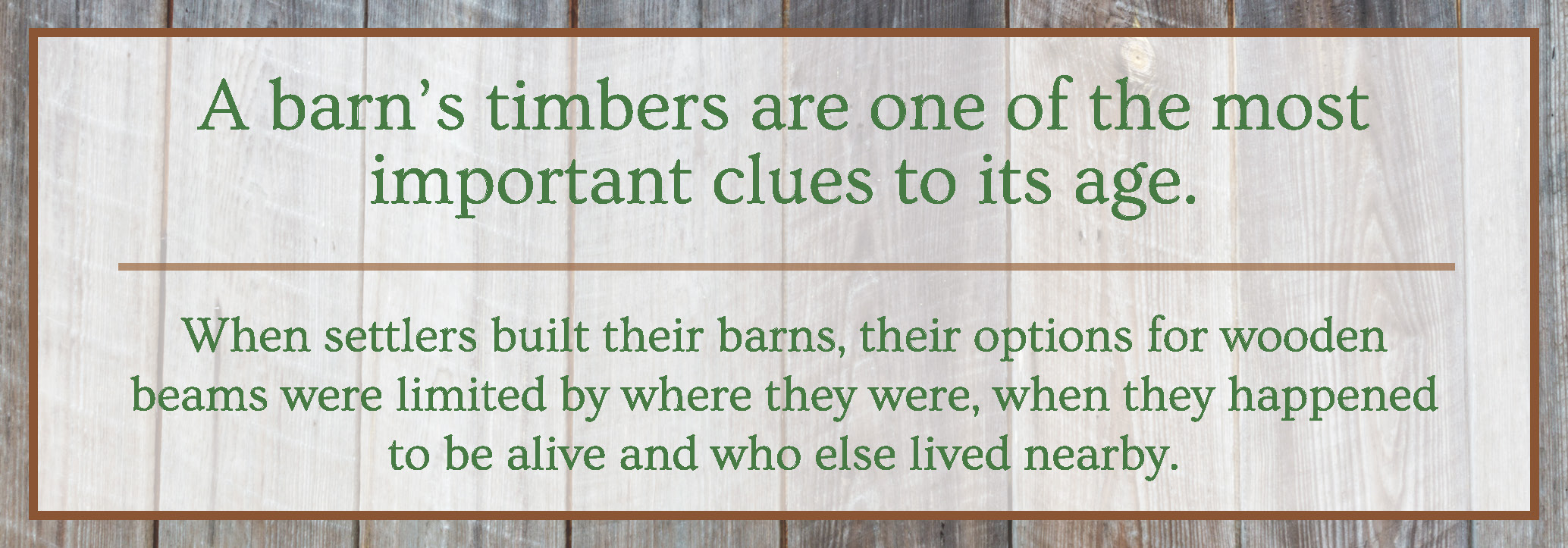
- Axe: Farmers who struck out into the wilderness alone often had no means of hewing logs other than their own axe. The marks of an axe-hewn beam are very distinct: They bear long, smooth divots formed by the blade’s motion across the wood. If the beams in your barn are hand-hewn, it is entirely possible you are dealing with a very old barn. Check the history of your area to see when the settlers arrived — your barn is probably in that date range.
- Pit saw: This hand-powered tool was essentially a saw blade that ripped beams in half. The user would walk along the top of the beam and saw through its center. Alternatively, the saw would have two handles, and one person would pull from above, while another pushed from below. The earliest settlers also used this kind of saw, so signs of its use place your barn in an older age range. Its marks are irregular gouges that run up and down.
- Gash saw: The distinct marks of the gash saw are easy to recognize. These vertical, chipped marks were made when this water wheel-powered saw blade cut through beams. Gash saws came to the east coast in the 1600s, and were in use through the mid-19th century.
- Circular saw: The circular saw came into being in 1860 with the help of steam power, and woodworking was never the same again. Its circular saw marks are easy to identify, and place the barn after the Civil War.
Come to Superior Hardwoods
Old barns and the wood that comprises them are a part of our history. At Superior Hardwoods, beautiful wood is our passion. Not only do we pride ourselves on the reclaimed timbers that made America — all our products are also made in America. And we back up everything we do with the best customer service in the business.
Reclaiming antique wood is a rewarding endeavor, and we’re pleased to share it with so many of our customers. All our antique and reclaimed flooring is 100 percent authentic — that means 100 percent antique and 100 percent usable. Additionally, reclaimed wood saves trees and preserves our nation’s history. Whether you are remodeling or installing hardwood floors, we have the right wood in stock.
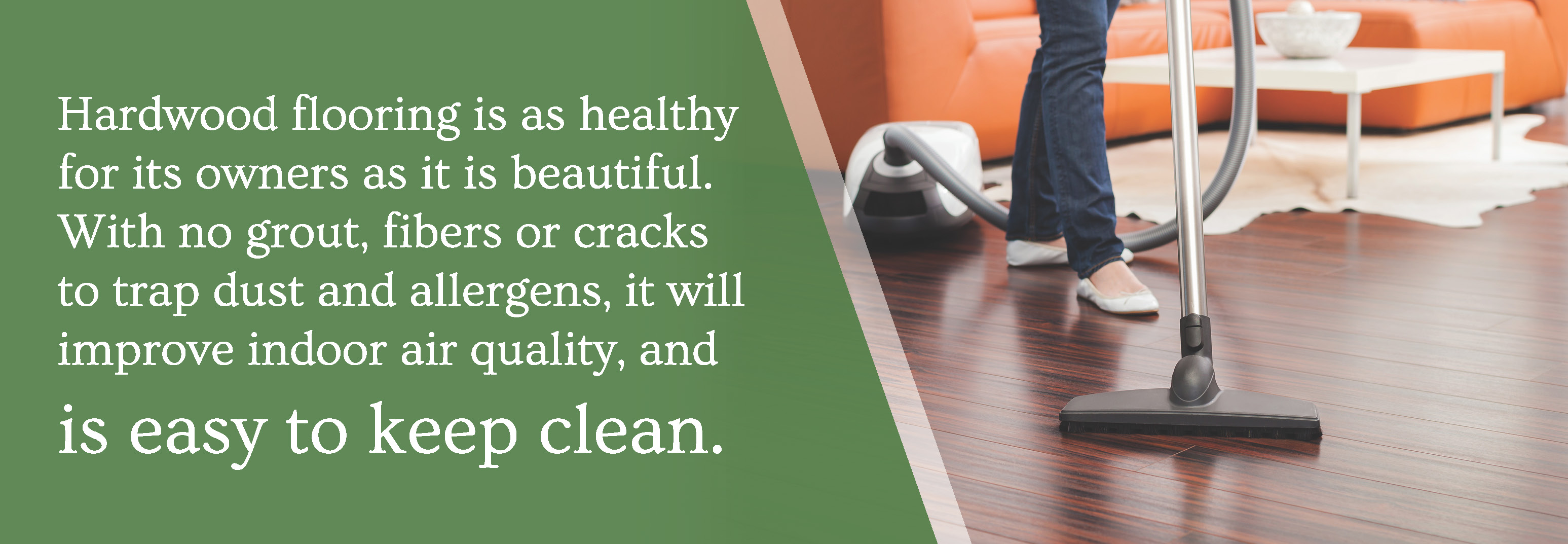
Hardwood flooring is as healthy for its owners as it is beautiful. With no grout, fibers or cracks to trap dust and allergens, it will improve indoor air quality, and is easy to keep clean. We strive to help our customers make educated purchases, and when it comes to hardwood flooring, there are a lot of incredible features to learn about.
So if all this talk of reclaimed wood makes you yearn for your own piece of history, visit Superior Hardwoods and let us guide you through the woods.